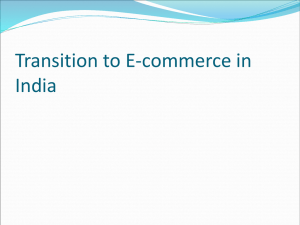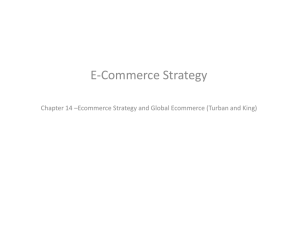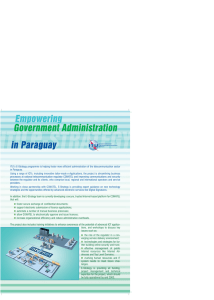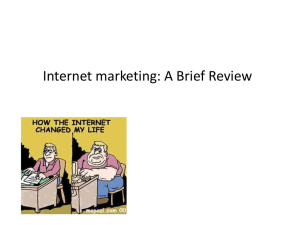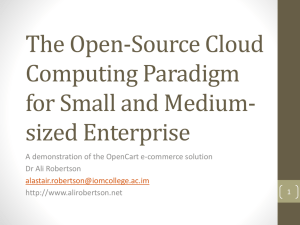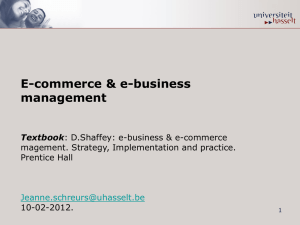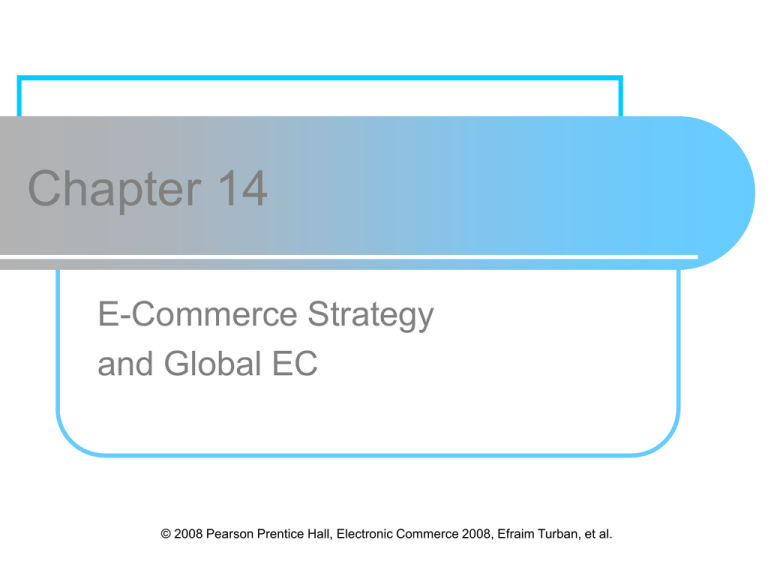
Chapter 14
E-Commerce Strategy
and Global EC
© 2008 Pearson Prentice Hall, Electronic Commerce 2008, Efraim Turban, et al.
Organizational Strategy:
Concepts and Overview
strategy
A broad-based formula for how a
business is going to accomplish its
mission, what its goals should be, and
what plans and policies will be needed to
carry out those goals
14-2
Organizational Strategy:
Concepts and Overview
Strategy and the Web Environment
e-commerce strategy (e-strategy)
The formulation and execution of a vision of
how a new or existing company intends to
do business electronically
14-3
Organizational Strategy:
Concepts and Overview
Strategy and the Web Environment
strategic information systems planning
(SISP)
A process for developing a strategy and
plans for aligning information systems
(including e-commerce applications) with
the business strategies of an organization
14-4
Organizational Strategy:
Concepts and Overview
The Strategic Planning Process
Strategy initiation
Strategy formulation
Strategy implementation
Strategy assessment
14-5
Organizational Strategy:
Concepts and Overview
14-6
Organizational Strategy:
Concepts and Overview
strategy initiation
The initial phase of strategic planning in
which the organization examines itself
and its environment
14-7
Organizational Strategy:
Concepts and Overview
Specific outcomes initiation phase
include:
Company analysis and value proposition
value proposition
The benefit that a company’s products or
services provide to a company and its customers
Core competencies
Forecasts
Competitor (industry) analysis
14-8
Organizational Strategy:
Concepts and Overview
strategy formulation
The development of strategies to exploit
opportunities and manage threats in the
business environment in light of
corporate strengths and weaknesses
14-9
Organizational Strategy:
Concepts and Overview
Specific activities and outcomes from the
formulation phase include:
Business opportunities
Cost-benefit analysis
Risk analysis, assessment, and
management
Business plan
14-10
Organizational Strategy:
Concepts and Overview
strategy implementation
The development of detailed, short-term
plans for carrying out the projects agreed
on in strategy formulation
14-11
Organizational Strategy:
Concepts and Overview
Specific activities and outcomes from the
strategy implementation phase include:
Project planning
Resource allocation
Project management
14-12
Organizational Strategy:
Concepts and Overview
strategy assessment
The continuous evaluation of progress
toward the organization’s strategic goals,
resulting in corrective action and, if
necessary, strategy reformulation
14-13
Organizational Strategy:
Concepts and Overview
Strategic Planning Tools
SWOT analysis
A methodology that surveys external
opportunities and threats and relates them
to internal strengths and weaknesses
competitor analysis grid
A strategic planning tool that highlights
points of differentiation between competitors
and the target firm
14-14
Organizational Strategy:
Concepts and Overview
scenario planning
A strategic planning methodology that generates
plausible alternative futures to help decision
makers identify actions that can be taken today to
ensure success in the future
balanced scorecard
A management tool that assesses organizational
progress toward strategic goals by measuring
performance in a number of different areas
14-15
Business Planning in E-Commerce
business plan
A written document that identifies the
company’s goals and outlines how the
company intends to achieve those goals
14-16
Business Planning in E-Commerce
Outline of a business plan
Executive Summary
Business Description
Operations Plan
Financial Plan
Marketing Plan
Competitor Analysis
14-17
Business Planning in E-Commerce
Business Plan Fundamentals
Purposes for business plan
To acquire funding
To acquire nonfinancial resources
To obtain a realistic approach to the business
business case
A business plan for a new initiative or
large, new project inside an existing
organization
14-18
E-Business Strategy:
Concepts and Overview
14-19
E-Strategy Initiation
Issues in E-Strategy Initiation
Be a First Mover or a Follower?
Born-on-the-Net or Move-to-the-Net?
Determining Scope
Have a Separate Online Company?
Have a Separate Online Brand?
14-20
E-Strategy Formulation
Selecting EC Opportunities
Incorrect approaches to EC strategy selection:
1. Indiscriminately funding many projects and hoping for a
few winners
2. Betting it all in a single, high-stakes initiative
3. “Trend-surfing”
Productive approaches to EC strategy selection
1.
2.
3.
4.
Problem-driven strategy
Technology-driven strategy
Market-driven strategy
E-business maturity model
14-21
E-Strategy Formulation
Determining an Appropriate EC
Application Portfolio Mix
The BCG model
An Internet portfolio map for selecting
applications
14-22
E-Strategy Formulation
14-23
E-Strategy Formulation
Risk Analysis and Management
e-commerce (EC) risk
The likelihood that a negative outcome will
occur in the course of developing and
operating an electronic commerce strategy
Security issues
14-24
E-Strategy Formulation
Issues in Strategy Formulation
How to handle channel conflict
How to handle conflict between the off-line and
online businesses
Pricing strategy
Price comparison is easier
Buyers sometimes set the price
Online and off-line goods are priced differently
Differentiated pricing can be a pricing strategy
versioning
Selling the same good, but with different selection and
delivery characteristics
14-25
E-Strategy Implementation
Create a Web Team
project champion
The person who ensures the EC project
gets the time, attention, and resources
required and defends the project from
detractors at all times
Start with a Pilot Project
Allocate Resources
Manage the Project
14-26
E-Strategy Implementation
Strategy Implementation Issues
Application development
Partners’ strategy
outsourcing
The use of an external vendor to provide all or
part of the products and services that could be
provided internally
14-27
E-Strategy Implementation
Business alliances and virtual corporations
virtual corporation (VC)
An organization composed of several business
partners sharing costs and resources for the
production or utilization of a product or service
co-opetition
Two or more companies cooperate together on
some activities for their mutual benefit, even while
competing against each other in the marketplace
14-28
E-Strategy Implementation
Redesigning business processes
business process reengineering (BPR)
A methodology for conducting a comprehensive
redesign of an enterprise’s processes
14-29
E-Strategy Implementation
business process management (BPM)
Method for business restructuring that
combines workflow systems and redesign
methods; covers three process categories—
people-to-people, systems-to-systems, and
systems-to-people interactions
14-30
E-Strategy and Project Assessment
The Objectives of Assessment
Measure the extent to which the EC strategy and
ensuing projects are delivering what they were
supposed to deliver
Determine if the EC strategy and projects are still
viable in the current environment
Reassess the initial strategy in order to learn from
mistakes and improve future planning
Identify failing projects as soon as possible and
determine why they failed
14-31
E-Strategy and Project Assessment
Measuring Results and Using Metrics
metric
A specific, measurable standard against
which actual performance is compared
corporate (business) performance
management (CPM, BPM)
Advanced performance measuring and
analysis approach that embraces planning
and strategy
14-32
E-Strategy and Project Assessment
14-33
E-Strategy and Project Assessment
Web analytics
The analysis of clickstream data to
understand visitor behavior on a Web
site
14-34
Global E-Commerce
Benefits and Extent of Operations
The major advantage of EC is the ability to
do business at any time, from anywhere,
and at a reasonable cost
14-35
Global E-Commerce
Barriers to Global EC
Cultural issues
Culture and language translation
Administrative issues
Geographic issues and localization
Economic issues
14-36
Global E-Commerce
Breaking Down the Barriers to Global
EC
Be strategic
Know your audience
Localize
Think globally, act consistently
Value the human touch
Clarify, document, explain
Offer services that reduce barriers
14-37
E-Commerce in Small and
Medium-Sized Enterprises
Advantages and Benefits of EC to Small
and Medium-Sized Enterprises
Inexpensive sources of information
Inexpensive ways of advertising and conducting
market research
Competitor analysis is easier
Inexpensive ways to build storefronts
Less locked into legacy technologies
Image and public recognition can be generated
quickly
An opportunity to reach worldwide customers
14-38
E-Commerce in Small and
Medium-Sized Enterprises
Disadvantages and Risks of EC to Small
and Medium-Sized Enterprises
Lack of financial resources to fully exploit the Web
Lack of technical staff or insufficient expertise in
legal issues, advertising, etc.
Less risk tolerance than a large company.
Products not suitable for online sales
Reduced personal contact with customers
Inability to afford the advantages of digital
exchanges
14-39
E-Commerce in Small and
Medium-Sized Enterprises
Critical Success Factors for SMES
Product is critical
Payment methods must be flexible
Electronic payments must be secure
Capital investment should be kept to a
minimum
Inventory control is crucial
Logistics services must be quick and
reliable
14-40
E-Commerce in Small and
Medium-Sized Enterprises
Critical Success Factors for SMES
Owner support
High visibility on the Internet
Join an online community
A Web site should provide all the services
needed by consumers
Supporting SMES
Government agencies
Vendor service centers
14-41
Managerial Issues
1. What is the strategic value of EC to the
organization?
2. Who determines EC strategy?
3. What are the benefits and risks of EC?
4. Why do we need a plan?
5. What metrics should we use?
14-42
Managerial Issues
6. What staffing is required?
7. How can we go global?
8. Should the dot-com activities be spun
off as a separate company?
9. Can we learn to love smallness?
10. Is e-business always beneficial?
14-43


